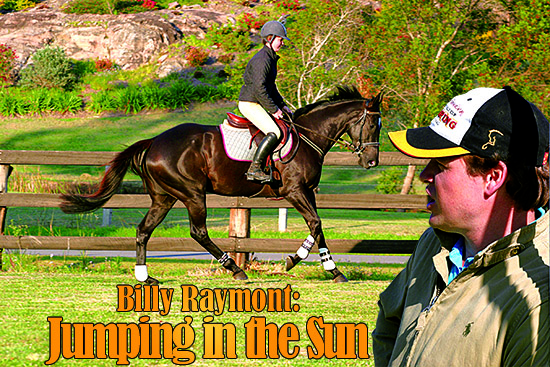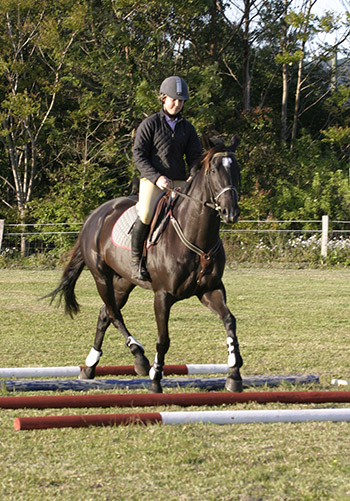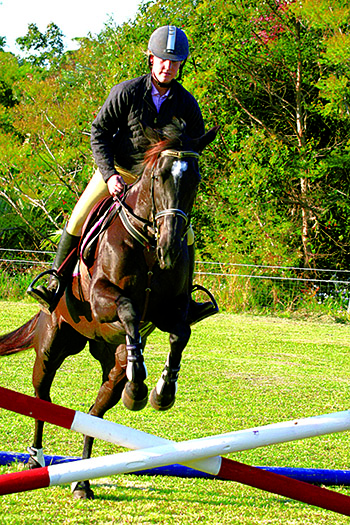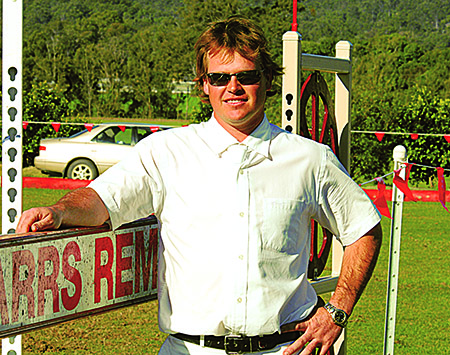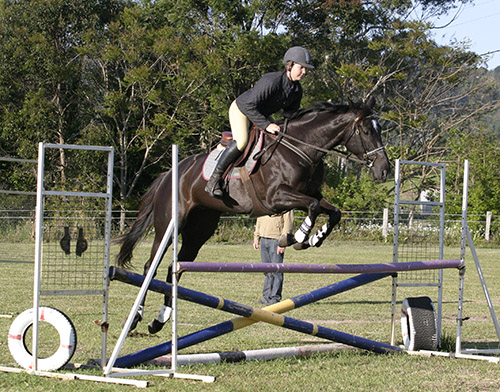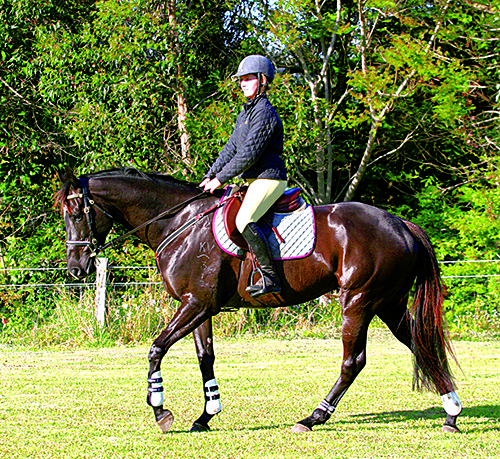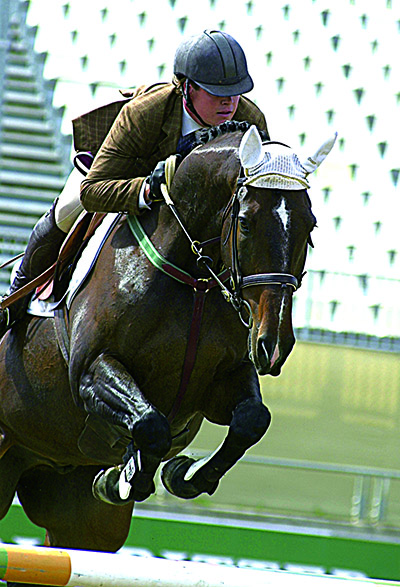Alexandra Bruggisser checks out one of the up-and-coming stars of the showjumping scene.
Rod Scott took the photos…
What would you do if you won the Australian World Cup Show Jumping League? 2005 champion, Billy Raymont sold his horse and went horseless to Las Vegas to watch the FEI World Cup finals! Then he detoured en route back to Australia to base himself with Dutchman Henk Nooren, the Swedish team coach. And there he found plenty of horses…
A typical day with Nooren would see Billy ride six horses and at some point have a dressage lesson as well as a jumping lesson. After riding, he was Nooren’s shadow, travelling around to look at horses, watching lessons or going to shows. Sounds perfect but how much can be taken in, learnt and retained from one month on a working holiday?!!
My current assignment for THM, a two-part series beginning with a green horse, following with a horse ready for low-level competition and concluding with an experienced horse in competition preparation, gave me the opportunity to check out the training methods of one of Australia’s rising jumping stars. It took me to the Sunshine Coast to see what’s shaping our new generation of coaches and riders in Queensland.
Luckily for me, Billy has avoided the lurgy of EI and agreed to be the coach in the show jumping series. One of his dedicated pupils even still had horses in work! Packing my surfboard for my own version of a working holiday, I took off on a road trip to find out how this smorgasbord of European experience influenced Billy. Listening to him, it is obvious that the time in Holland has influenced the way he trains his horses and young riders today.
Three important things Billy says were reinforced for him whilst away: Work for number 1 – getting the horse relaxed. This allows for number 2 – encouraging the horse to use its neck and shoulders and follows to number 3 – letting the jump come.
Initially Billy struck me as quite a conservative horseman… That is until I heard the story of the bridles made from gun straps and the influence of a radical Swiss who trains bareback. I admit Billy did say, the bridles were made in his early riding career, by a fellow up the road. In those days he rode without a saddle and says this helps him understand the importance of a still position emphasized by Beat Mändl. Mändli is this year’s FEI World Cup Show Jumping Champion and is known for schooling his horses bareback to train himself to keep his position absolutely still. I can relate to that, I remember the days where saddling up was too much effort so I rode to school bareback, jumping logs on the way. It would be great to see an exhibition of bareback riding with someone of this calibre – perhaps they could put on a competition at the next World Cup final!!
Billy brings me back to the here-and-now as he discusses the real purpose of bringing up Mändli’s habit – just how important the position your saddle puts you in, is to allowing the horse the freedom to jump.
It’s obvious that Billy puts what he believes into practise as he guides 15 year old pupil, Kym Hilly, through the “basics of starting a young one”. There is consistent emphasis on the importance of maintaining a still position, in encouraging the horse to relax and start to use itself more.
Kym, a Year 10 student, is on the Queensland Show Jumping Young Rider Squad and has been training with Billy for two years. For today’s lesson we have Little Miss Sunshine, better known as ‘Betty’, as our model of a green horse. The 6 year old, un-raced, Thoroughbred mare was taken off-the-track by Billy. He liked her type and was also partial to her breeding, having had previous positive experiences with the trainability and temperament of horses from the Marr family’s successful breeding program using the stallion Waterford Road (by Danehill). Betty is fresh in the early breezy morning. Kym on the other hand has admitted to not being much of a morning person and after a late night is feeling a little jaded.
“Ok, have a trot around on a loose contact first and let her just relax and have a look around the paddock for a few minutes, once she feels a bit warmer you can start to take a bit of contact, put a bit of pressure on her get a bit of connection ok… Start to put pressure on her now, connection and get organised. Yeah good.”
Within minutes the combination are working together in a soft outline.
“Go to a rising trot when you’re ready and open her trot up and bring her back. Play with your accelerator and brakes. Get her more responsive and ready to start doing some exercises. Click, click, click. Come on. Come on, let her trot, open her trot up, open your trot up, open your trot up. Good, good. Now if you want you can sit the trot and bring it back, bring it back, bring it back. Close it, keep your leg on it. Ok, just get it organised and have a canter now.”
The mare is an elegant, athletic type and so far is following Kym’s cues. It’s easy to imagine them cutting a fine figure in the show ring. Back to reality and the hard work still to be done…
“Your hands are just a little in your lap maybe just shorten your contact. Same thing now at the canter, just play with your accelerator and breaks. Don’t open her up too much, but just a little bit and then bring it back. Sit on it, sit on it to bring it back.”
Exercise 1: 4 poles on the ground
This is a straightforward exercise we see many times and is easily replicable at home. Billy explains his strategy for Betty with this exercise:
“This is a youngster that’s never jumped before, so we’re going to start walking her over these poles, with just a little contact so you can keep her straight and organised, but soft as well so she can stretch and look at the poles and just feel where her feet are. The idea is just starting to get her to use her neck at the same time getting her to think of using her shoulder.”
The mare walks through obediently stretching through her neck and looking down at the poles. “Ok she’s fine with that, so trot. Exactly the same, just keep a contact so she can stretch her neck and look at the poles. Separate your hands to let her stretch.”
At the trot, Betty is not relaxing as Billy would like, but it is breezy and there are strangers around. “She’s still a bit over-reactive because she’s just not quite relaxed yet. Come through, circle left, go back across and through the other way. So when you come off the end keep it straight, get to the fence, circle left then come back across, and give yourself some room so you can go back this way. Then do it going back to the right.”
“Straight, straight. Constantly think about keeping her body straight, ok.”
Obviously very comfortable with her coach, Kym asks “Do you mean like straight even when I’m going around a circle?” and Billy is quick to respond, “Aah look you’ve still got to have a bend on your circle for sure. But be careful to keep it within straight.” I pondered for a minute what he meant by “within straight”. My interpretation is, not crooked or over-bent but consistently bent around the leg and this is exactly how Kym seemed to ride.
And as they continued to ride, Billy kept asking for relaxation… “She just still looks a bit fresh to jump. She’s just not quite relaxed. We have to stick with this (exercise) with the young ones until they are relaxed. Each step that we make forwards in training, they’ve got to become relaxed with that, before we can move on. That’s better, good. Try to just close her up. Wait a little so you can soften. Yeah ok. Have a walk.”
I understand what Billy is saying with the progressive desensitisation as we move through elements of training and I remember his Number 1 point from Holland, to stay relaxed. He explained to me that it was in Holland that it became so apparent that relaxation has to come first. The way the riders worked the horses was always in this manner. Even at shows, experienced horses would be entered in smaller classes on the first day of a show and only step up to the bigger classes in later days when they were more confident.
Exercise 2: trot pole, cross rail, trot pole
“So the next step with a horse that hasn’t really jumped before is to add a little jump in here to the exercise that you’ve already been using. She’s confident with this area and these poles. It’s basically the same thing. The idea is to let her stretch her neck more, getting her to use her neck but also getting her to work her shoulder more now. She knows where the poles are, she has some idea of where her feet are, so now we just want to keep her straight and stay soft. If she’s going to jump a little bit big, try not to get loose in your position. It’s important to keep your position and not offend her in any way. Basically here we’re doing the same thing but with a little jump incorporated now.”
The young mare handles the question with ease…
“We can just make that a little bigger, she’s pretty confident with this, while we’re here, while she’s happy to do this. Not too much but just enough to get her to think about using her shoulder a little more. All that isn’t so important at this level, but you know we want to start training it right from the start. Try to establish a technique, not with too much pressure in the beginning, just so she can think about how she wants to jump a fence. We have to be careful not to put too much pressure on her so that she starts doing awkward things and gets into bad habits.”
When I have seen this exercise previously with young horses there has sometimes been a tendency to push on too quickly before the horse has accepted what it has learnt enough to truly relax. Billy certainly wasn’t in a hurry and when I asked him later about whether he has a plan for his students, he says it is the staging of the training that he emphasises. The horse must be relaxed and coping with the pressure of each exercise before it moves on.
Exercise 3: canter pole, cross rail, canter pole
“We’ll just try this at the canter now, just so she’s cantered over a few and then we can canter her over a few new fences and just see what she thinks of that. Same thing, keep a connection and then just soften and let her use her neck. Good. That’s ok, that’s ok.”
Again it is obvious that Betty is feeling quite fresh and with another change to the exercise she gets a little over excited and jumps big and awkwardly scuffles out over the second pole. Unfazed by this reaction it is… “Same again, come off your left rein. Just have one more. Keep coming…”
“Trot up to the house and get your eyes.”
“What?!!”
“Trot up to the house and get your eyes… you must have left them in bed!!” There is a light hearted atmosphere as Billy gently reminds Kym of the important role she plays in teaching the young horse.
Exercise 4: cantering over jumps
Again showing the gradual progression of the exercises when the time is right, Billy continues… “Ok so now that we’ve worked through that, we want to canter around over a few little jumps, just keeping her really relaxed, basically just as if you were schooling her on the flat. So concentrate mostly on that and we’re just going to blob around and pop over some little things, stay really relaxed so that she isn’t really thinking about it. So she’s just having a little jump around, it’s simple and easy. Keep cantering around as if you’re flatting her (riding her on the flat), popping over some little jumps without too much change, so she doesn’t think too much of it.”
“Good. Ok let’s jump something else. Basically here we want to pop round over a few little jumps, still keeping her relaxed. Having her thinking about using her neck by staying soft. Also encouraging her to use her shoulder, but not too much pressure – 60 cm is heaps. The main thing at this level is that they stay relaxed. At this point all we want to do is take lots of time. You know, jump one fence and relax, get her organised again, just get her back so she’s relaxed before you go onto another one. We’re not trying to do any lines or anything. We just want to get around, have a pop, get her relaxed, have a pop, and get her relaxed. Then as she is happy with that we can start to put more pressure on and start to play with a few little lines and things like that.”
“It’s important that when you jump something like the gate that if she over-jumps, you’ve got to be careful you stay really still, don’t offend her with extra body movement.”
So maybe this is what Mändli uses his bareback training for!!
“At this stage she needs you to be as supportive as possible, just let her relax and find her own jump. A little bit more of that before we move on. So jump one and take as long as you like before you come back and jump another one. Give yourself enough time to get her organised.”
“This is better now where she is just cantering around like she’s on the flat, popping over jumps, not really changing her rhythm too much. She’s just learning that jumping around is no big deal. When she feels relaxed enough and when she feels as if she’s done enough with this work you can maybe start to do a couple of little lines.”
“Once you feel as though she is really confident with this exercise, and she’s staying quite relaxed, she’s keeping an even rhythm and staying quite straight in her jump and she’s giving you the feeling that she’s happy enough with that and she’s ready to move on, then you can start playing with some lines. Ok. Pop one and then just get her to canter down to the other, whether they’re on a bend or straight, but just start putting your jumps together more.”
“What you’re doing there now just popping around is a good way to start a youngster, but it’s also good for the older horses to come back and do a bit of that. It just takes some of the pressure off and gets them relaxed about jumping around again. Gets them happier about you being on their back. It just takes the pressure away with the older ones, with the younger ones we’re just trying to slowly, slowly, incorporate a little more pressure, just introduce it all slowly so we don’t give her mind too much to think about at the one time.”
I asked Billy, where the exercises went from there? We continued and he demonstrated… “Say you’ve been jumping around doing that for a few days and she feels quite good, you can start to make it happen quicker. So maybe you can jump the gate and come down to one of the others now. Ok, but again it’s important to keep your position. If she over-jumps you’ve got to be still, ready to land, take your contact back and have her organised so that you can just canter down and jump another one. You’ve got to speed up the time it takes to be able to get them organised on landing before you can do more jumps. Ok try that, maybe just canter around and jump one first and then jump a line.”
“She’s getting more and more relaxed, which they need to be, she’s got to be able to cope with that. For me, with the youngsters, you want to be able to soften in your jump, soften your body, soften your contact so they can use their neck in the way they want to and start to use their shoulder. But, sometimes when they’re green they want to do things like run away in their jump, they just get disorganised. For me, I don’t think it hurts, with the young ones or even with the older ones for that matter, when they need it, keeping a little feel of their mouth and just persuading them to stay within the contact. I think you should always keep a little feel of their mouth all the way through the jump, while putting ourselves in a position to be soft, they can take the contact to make a shape. But again, it’s important to sit really still and be in that position where they can take the contact, but not fall back on the contact and offend themselves in any way.”
Exercise 5: grid work
“One of the next best exercises to move to is grid work, so we can get her popping through an exercise over and over and over so she gets used to it and stays relaxed. As she gets relaxed, we can start to make them bigger and put more pressure on her. Getting her using her shape more, thinking about using her body more, developing her technique and also getting her used to jumping a bigger fence without having to worry about distance and things like that.”
“After having popped around over little tiny stuff and find her nice and relaxed with it, getting her more organised, then she’s hopefully ready to put more pressure on and jump some bigger tracks.”
“When we start off, we only putting a back rail on the oxer out, keeping an x in front because we don’t want her to start pushing back under herself. We want to keep her knees coming up a little, stretching up to that back rail. Kind of working on her technique as well as her mind now.”
“Like every exercise ’til now, it’s important to concentrate on keeping her straight as well. If you don’t keep her straight you won’t find their true technique. If we let them shift from one side to the other too much they tend to roll their front end or their back end. They’ve got to stay straight through the body and in their jump and that will keep their legs straighter and tends to make them do the right things with them more. Just let her jump out of there on her own this time. Good, good. Ok. Lets cool her down that’s enough for today.”
Billy Raymont – Jumping to the top…
While Billy admits it would be great to base himself overseas, like Edwina Alexander, he likes it back here in Oz. Little wonder, growing up on the picturesque Sunshine Coast near holiday hotspot, Noosa! But apparently Billy never has time for coastal life activities like the beach “Every time I think I’ll go for a swim, I think about a horse I should be riding”. And he has been riding horses for longer than he can remember, in a comparison drawn by my advertising guru brother-in-law, he and riding go together like Bert Newton and Channel Nine.
From Billy’s first pony, bought for his Dad’s youngest brother but still hanging around on the family farm, show jumping has always appealed to him. His first pony club horse was won in a raffle as a yearling. Continuing the family affair it was broken in by his Dad and Billy started his horse-training career educating this new pony. It is a wonder that show jumping was still top of his priority list as this cheeky pony ditched him before every fence for the first 12 months he rode it.
From here, Billy’s career snowballed as he started to acquire horses off-the-track. A string of horses that started developing Billy’s livelihood followed including Martian Star, Starmaker, his first World Cup horse Rocky Bay, Al-Lando a horse he developed to Grand Prix before Vicki Roycroft received the ride, as well as his first seriously good horse, World Cup League winner, Royal Selections.
Even in an ideal world where he would be riding a stable of top horses (like those he has now: Stardom, Ampolla and Dutch Choice), Billy shows quite an altruistic side when he says that he likes to help other people for what they get out of it. I question whether this is more for younger riders and he explains that he thinks he also has things to offer those that are more experienced too.
At the moment he has eight young ones in work. Many of his top horses have been off-the-track and I ask if he has a preference for Thoroughbreds. He clarifies that at the end of the day, he likes dealing with both, and furthermore, when they’re both doing the same job he doesn’t see why one should be worth more.
Currently Billy’s top horse is Balmoral Tim Tram an ex-eventer, by Sir Tristram, trained and successfully evented by Simone Kann up to Intermediate level. With the huge training improvements the horse had made earlier this year the pair were aiming for Beijing… that was before Equine Influenza broke out. Now?
“Who knows what will happen, maybe he will still get there, otherwise there are no plans to sell him so maybe something in the near future after that.”
Billy and his World Cup winner, Royal Selections…
This story originally appeared in the November 2009 edition of The Horse Magazine



